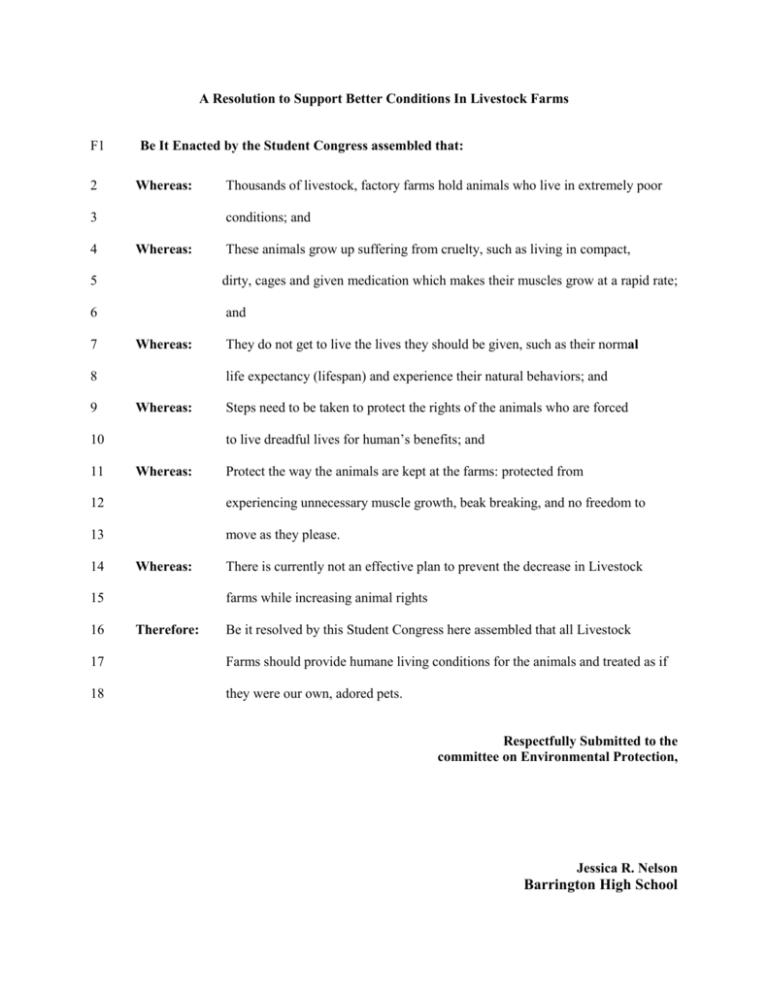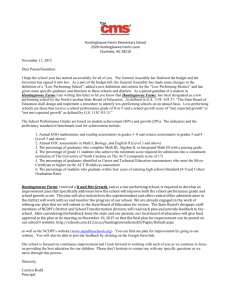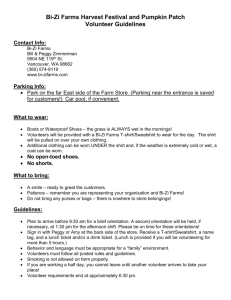Source: Brian Sherman, “Bring Tidings of Comfort
advertisement

A Resolution to Support Better Conditions In Livestock Farms F1 2 Be It Enacted by the Student Congress assembled that: Whereas: 3 4 Thousands of livestock, factory farms hold animals who live in extremely poor conditions; and Whereas: These animals grow up suffering from cruelty, such as living in compact, 5 dirty, cages and given medication which makes their muscles grow at a rapid rate; 6 and 7 Whereas: 8 9 life expectancy (lifespan) and experience their natural behaviors; and Whereas: Steps need to be taken to protect the rights of the animals who are forced to live dreadful lives for human’s benefits; and 10 11 They do not get to live the lives they should be given, such as their normal Whereas: Protect the way the animals are kept at the farms: protected from 12 experiencing unnecessary muscle growth, beak breaking, and no freedom to 13 move as they please. 14 Whereas: 15 16 There is currently not an effective plan to prevent the decrease in Livestock farms while increasing animal rights Therefore: Be it resolved by this Student Congress here assembled that all Livestock 17 Farms should provide humane living conditions for the animals and treated as if 18 they were our own, adored pets. Respectfully Submitted to the committee on Environmental Protection, Jessica R. Nelson Barrington High School Arguments and Evidence-Pro Pro Argument #1: All the animals do not get to experience their natural behaviors. Evidence: “1) Chickens are prevented from carrying out many of their complex social and natural behaviors such as roosting, perching and foraging. 2) Cage dimensions for all pigs are only slightly larger than the pig's body. In a space this size, this highly intelligent and social creature cannot even turn around, let alone express their natural behaviors, such as a mother pig using her powerful desire to nest to prepare for her brood, and to root with her snout.” Source: Brian Sherman, “Bring Tidings of Comfort to the Creatures in Our Factory Farms,” CQ Researcher, December 23, 2011 Pro Argument #2: Factory farms are directly to blame for the increase in many illnesses, such as food borne outbreaks. Evidence: “…but some innovations have caused new problems, including the spread of antibiotic-resistant infectious agents and the proliferation of hormones in meat. In addition, residents living near massive livestock operations say they suffer from a variety of air- and water-borne illnesses resulting from CAFO-related pollution.” Source: Adriel Bettelheim, "Drug-Resistant Bacteria," CQ Researcher, June 4, 2003 Pro Argument #3: Due to the fact that the animals raised on factory farms are given steroids, their muscles grow at a rapid rate, causing them to be full grown at young age. People would typically title these meats as “Cheap Meat,” because there is a great amount of the meats; therefore many people can buy them at a cheap cost. Evidence: “Factory farms can produce large quantities of food cheaply; however animalwelfare advocates call them inhumane, and environmentalists and local residents say they generate pollution and noxious odors and byproducts.” Source: Don P. Blayney, “The Changing Landscape of U.S. Milk Production,” U.S. Department of Agriculture, Economic Research Service, Statistical Bulletin, June 2002 Pro Argument #4: Many restaurants, fast food chains, and grocery stores are making an effort to fight against inhumane conditions at livestock factory farms and feedlots. Evidence: “"[T]the biggest restaurant chain on the planet, McDonald's, lined up on the same side as the Humane Society of the United States on a major issue of animal welfare. It informed its pork suppliers that they will have to stop confining pregnant sows in 'gestation crates' that are too small to let the animals turn around… McDonald's was preceded by such mainstays of American consumer culture as Burger King, Wendy's, Sonic and Winn-Dixie Stores, which have moved against gestation crates (Chicago Tribune).” Source: Steve Chapman, “Food and Conscience,” CQ Researcher, December 23, 2011 Pro Argument #5: The animals should be treated like one’s pet because they too are animals, many of which are just as smart as dogs. Overall, factory farms are cruel, inhumane places. Animals that are forced to give up their lives for the benefit of human use should be treated very well. Evidence: “Pigs are highly intelligent and social creatures, at least as smart and sensitive as a dog. The state they are in would be subject to prosecution if committed against a dog. Yet methods of production like these are sanctioned by commonwealth and state farm animal welfare codes, and by state and territory laws that effectively deem farm animal suffering "justifiable", "necessary" and "reasonable" on economic grounds.” Source: Brian Sherman, “Bring Tidings of Comfort to the Creatures in Our Factory Farms,” CQ Researcher, December 23, 2011 Arguments and Evidence-Con Con Argument #1: It is very expensive to buy antibiotics that help numb or knock out the animals before they are mistreated or killed. Evidence: “…Kremer stopped using antibiotics or growth hormones in his pigs and says his new methods not only are safer for humans but also save him $12,000 a year on drug and vet bills.” Source: David L. Smith, Jonathan Dushoff and J. Glenn Morris, Jr., “Agricultural Antibiotics and Human Health,” PLoS Medicine, August 2005 Con Argument #2: Billions of people eat chicken; therefore the farms cannot wait until the chicks grow up at their natural rate. Evidence: “Many large farm operators routinely use antibiotics not just to treat sick animals but also to promote growth. The Food and Drug Administration (FDA) has approved 18 antimicrobial drugs for growth promotion in food animals. Half of these, including penicillin and erythromycin, are chemically similar or identical to drugs used by humans.” Source: Katherine M. Shea, “Antibiotic Resistance: What Is the Impact of Agricultural Uses of Antibiotics on Children's Health?” Pediatrics, July 2003 Con Argument #3: Conventional products are much cheaper than organic products. Evidence: “…organic farming is more labor-intensive and yields are generally lower, organic food usually costs about 25 percent more than conventional products. Organic milk costs even more — about $3.60 per half gallon, roughly double the price of conventional milk.” Source: U.S. Department of Agriculture, Economic Research Service, “U.S. Certified Organic Farmland Acreage, Livestock Numbers, and Farm Operations, 1992-2003 Con Argument #4: It is very expensive to buy spacious, individual cages for all the animals. Evidence: “Confinement is good for hogs,” says Joy Philippi, president of the National Pork Producers Council, who runs a nursery with 2,000 pigs in Bruning, Nebraska. “The barns are climate-controlled and well-ventilated, so livestock are protected from the weather. We can deliver feed and water to them 24 hours a day.” Source: Brian Hansen, "Crisis on the Plains," CQ Researcher, May 9, 2003 Con Argument #5: Lapses in food safety can happen at any point in the food supply chain, not just in factory farms. Evidence: “The U.S. food supply is safer and Americans are better nourished today than a century ago, thanks largely to scientific and technical innovations such as pasteurized milk, enriched breads and cereals and advances in veterinary medicine. Deaths from food-related illnesses such as diarrhea, typhoid fever and dysentery have fallen dramatically since the early 1900s, and nutritional deficiencies like scurvy, rickets and pellagra have been brought under control.” Source: D. J. Wagstaff, “Public Health and Food Safety: A Historical Association,” Public Health Reports, November-December 2004 Works Cited: Brian Sherman, “Bring Tidings of Comfort to the Creatures in Our Factory Farms,” CQ Researcher, December 23, 2011 Adriel Bettelheim, "Drug-Resistant Bacteria," CQ Researcher, June 4, 2003 Don P. Blayney, “The Changing Landscape of U.S. Milk Production,” U.S. Department of Agriculture, Economic Research Service, Statistical Bulletin, June 2002 Steve Chapman, “Food and Conscience,” CQ Researcher, December 23, 2011 David L. Smith, Jonathan Dushoff and J. Glenn Morris, Jr., “Agricultural Antibiotics and Human Health,” PLoS Medicine, August 2005 Katherine M. Shea, “Antibiotic Resistance: What Is the Impact of Agricultural Uses of Antibiotics on Children's Health?” Pediatrics, July 2003 U.S. Department of Agriculture, Economic Research Service, “U.S. Certified Organic Farmland Acreage, Livestock Numbers, and Farm Operations, 1992-2003 Brian Hansen, "Crisis on the Plains," CQ Researcher, May 9, 2003 D. J. Wagstaff, “Public Health and Food Safety: A Historical Association,” Public Health Reports, November-December 2004






